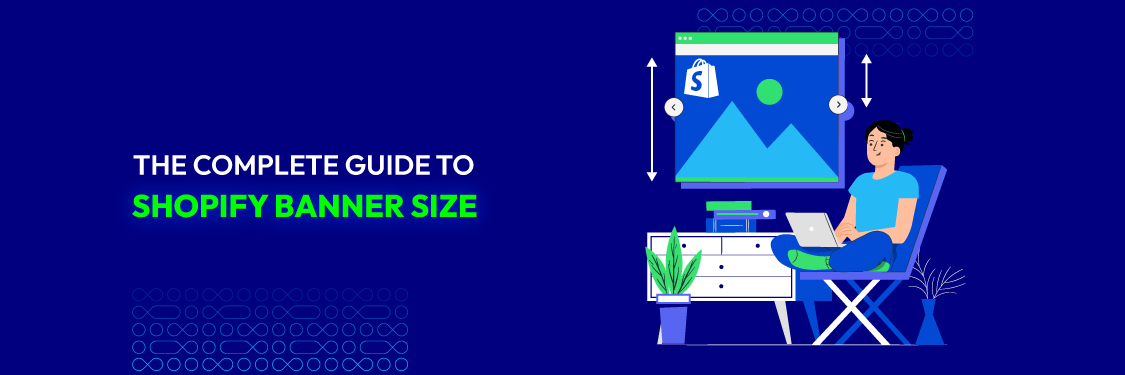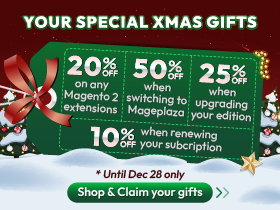The Complete Guide To Shopify Banner Size
Summer Nguyen | 01-16-2024

Creating an appealing and engaging online store is a fundamental aspect of any successful e-commerce venture. Your store’s visual presentation plays a pivotal role in attracting and retaining customers. One of the key elements in achieving this is optimizing the size and quality of your banners. In this comprehensive guide, we’ll dive into the recommended Shopify banner size, aspect ratios, and best practices to ensure your banners captivate your audience and enhance the user experience.
Table of Contents
Why is Shopify Banner Size Important?
Shopify banner size is important for several reasons, as it directly impacts how effectively the banner conveys its message and engages visitors to your online store. Here are some key reasons why banner size matters:
- Visibility: Larger banners are more noticeable, which is vital for highlighting important offers or calls to action on a busy webpage.
- Branding and aesthetics: Consistent design and branding require banners to fit harmoniously with the overall website layout, enhancing the site’s professional appeal.
- Readability: Properly sized banners ensure text is legible. Too small, and the text becomes hard to read; too large, and the text may appear disproportionately small.
- Mobile responsiveness: Banners must adapt to various screen sizes, maintaining readability and visual appeal on both desktops and mobile devices.
- User experience: Banners should enhance, not hinder, user experience. Overly large banners can dominate the screen, while too small ones may fail to convey the intended message effectively.
- Loading speed: Large, high-resolution banners can slow down website loading, negatively affecting user experience and SEO. Balancing banner size and quality is essential for fast load times.
- Conversion rates: Well-sized banners that effectively convey messages or promotions can increase conversion rates by attracting visitor attention and prompting the desired actions.
Shopify Banner Size Guidelines
Shopify banner images should ideally have a width of at least 1200 pixels and a height ranging between 400 to 600 pixels. This ensures they effectively span the top section of your webpage while accommodating various screen sizes.

Besides, you should consider the following points:
- Maximum image size: Keep in mind the maximum image dimensions allowed, which are 4472 x 4472 pixels, or up to 20 megapixels in size. This ensures that your banners maintain high-quality visuals while adhering to platform specifications.
- File size: To maintain fast-loading pages, the maximum image file size should not exceed 20 MB. It’s crucial to balance image quality and file size for optimal performance.
- Square images: If you require square-shaped banners, consider a size of 2048 x 2048 pixels. This is a commonly recommended dimension for banners with equal width and height, providing a balanced appearance.
- Zoom functionality: When implementing zoom functionality, which is essential for showcasing product details, the recommended size is 800 x 800 pixels at a minimum. This ensures that zoomed-in images remain clear and sharp.
- Height matters: The height of your banner is a critical factor, as it determines how much screen space it occupies. A banner with a height of 600 pixels will dominate most of the above-the-fold space, which is the portion visitors see immediately upon entering your website. Conversely, a height of 400 pixels will leave room for other page elements.
However, you should recognize that different banners may have unique image requirements to best fulfill their intended purpose. Tailoring your banner dimensions to suit your specific needs and considering the overall design and user experience of your store is essential for success.
Best Shopify Banner Sizes for Your Store
When determining the best banner sizes for your Shopify store, it’s important to consider your specific design, branding, and content needs. However, here are some commonly recommended banner sizes for various types of banners you might use on your Shopify store:
| Banner Type | Recommended Size (pixels) | Aspect Ratio | Notes |
|---|---|---|---|
| Header Banner | 400-600 (height) x 1200-2000 (width) | Variable, often 16:9 | Common size: 1920 x 1080 |
| Collection Banner | 2048 x 2048 | 1:1 | Square format for better mobile stacking |
| Slideshow Banner | 400-600 (height) x 1200-2000 (width) | Variable | Adjust aspect ratio to fill above-the-fold space |
| Blog Banner | 1800 x 1000 | 1.8:1 | Full-width banner for blog pages |
| Mobile Banner | 1200 x 600 | Variable | Ensure responsive design, test on different devices |
| Mobile Ad Banner | 320 x 50 | Standard | Standard size for mobile ads |
1. Shopify Header Banner Size

The header banner is a critical element as it’s the first thing visitors see when they arrive at your Shopify store’s homepage. It sets the tone for your entire site, making it essential to get the size right.
Recommended Size: For the header banner, it’s generally recommended to have an image between 400-600 pixels in height and 1200-2000 pixels in width. This allows the banner to be large enough to make an impact while accommodating various screen sizes.
Popular Size: A common size for the header banner is 1920 x 1080 pixels, which maintains an aspect ratio of 16:9. However, you can adjust this size to best fit your webpage’s layout and design.
2. Shopify Collection Banner

Collection banners, or collection images, play a crucial role in showcasing your product collections and can significantly influence conversions.
Recommended Size: Ideally, these banners should be square, with dimensions of 2048 x 2048 pixels. A square format is advantageous for better image stacking on mobile devices, ensuring your collections are presented attractively to users on various screen sizes.
3. Shopify Slideshow Banner

Shopify slideshow banners allow you to display multiple images with videos or captions in a sliding format, making them an engaging feature on your website.
Recommended Size: Slideshow images should typically be 400-600 pixels in height and 1200-2000 pixels in width. However, it’s important to adjust the aspect ratio as needed to achieve specific design objectives.
Purpose: Adapting the aspect ratio enables you to fill the “above-the-fold space” effectively (the part of a web page visible before scrolling) or make room for other content sections to appear below the slideshow images without requiring users to scroll.
4. Shopify Blog Banner Size

Similar to the header banner, the blog banner is a large image that spans the width of the screen. However, it’s typically used on blog pages rather than the homepage.
Recommended Size: If you want a full-width blog banner, aim for dimensions of 1800 x 1000 pixels, maintaining an aspect ratio of 1.8:1. Keep in mind that the specific size may vary based on your chosen Shopify theme and how much screen real estate you wish to cover with the background image.
5. Shopify Mobile Banner Size

For a Shopify mobile banner, the recommended size is typically 1200 x 600 pixels. However, the size can vary based on your site’s design and device display. Ensure your banner is responsive and tested on different devices for optimal appearance and functionality.
You can also consider other sizes, such as the standard 320 x 50 for mobile ads or a custom size that aligns with your theme and design.
What Shopify Banner File Format Should You Use and When Should You Use It?
The choice of file format for your Shopify banner depends on the type of image and its intended use. Here are common file formats and when to use them:
- JPEG (Joint Photographic Experts Group): JPEG is an excellent choice for photographs and images with complex color gradients, such as product photos and lifestyle images. It provides good compression while maintaining image quality. Use JPEG for realistic images that don’t require transparency.
- PNG (Portable Network Graphics): PNG is ideal for images with transparency or a need for a crisp, clear background, such as logos, icons, and graphics with sharp lines. Use PNG for graphics that require a transparent background or when you need to preserve fine details.
- GIF (Graphics Interchange Format): GIF is suitable for simple animations or images with limited colors. Use GIF for animated banners or graphics with few colors and sharp edges.
- WebP: WebP is a modern image format with good compression and image quality. It’s especially suitable for web graphics and banners, and it’s supported by many web browsers. Use WebP to improve the loading speed of your Shopify store without sacrificing image quality.
- SVG (Scalable Vector Graphics): SVG is a vector format suitable for logos, icons, and graphics that need to be scalable without losing quality. It’s a lightweight format that works well for responsive design. Use SVG for scalable and sharp graphics.
- TIFF (Tagged Image File Format): TIFF is a high-quality format best suited for images that require extensive editing and high color depth, such as professional photography. Use TIFF when you need the highest quality, and don’t mind larger file sizes.
- BMP (Bitmap Image): BMP is a less common format and is not ideal for web use due to its large file sizes. However, it might be used in specialized applications where high-quality, lossless images are required.

When choosing a file format for your Shopify banners, consider the content, purpose, and specific requirements of the image. JPEG and PNG are the most common formats for Shopify banners, with JPEG for photos and PNG for images with transparency. Use other formats like GIF, WebP, SVG, TIFF, or BMP as needed, based on the nature of your images and the technical requirements of your online store.
Best Practices for Shopify Banner Size
When it comes to Shopify banner sizes, adhering to best practices ensures a visually appealing and user-friendly online store. Here are some best practices for Shopify banner sizes:
- Optimize for responsiveness: Ensure that your banners are responsive and adapt to various screen sizes, including desktop, tablet, and mobile devices. Test how banners appear on different devices to maintain a consistent and attractive design.
- Use recommended sizes: Follow Shopify’s recommended banner sizes or the guidelines provided by your chosen theme. These standard sizes can simplify the design process and help your banners display well.
- Consider aspect ratios: Maintain consistent aspect ratios for your banners to create a uniform and polished look across your store. Common aspect ratios include 16:9 for widescreen displays and 1:1 for square banners.
- Customize as needed: While recommended sizes are a good starting point, feel free to customize your banner dimensions to match your specific design, branding, and content requirements. Just ensure that the banner remains visually balanced and doesn’t overpower the page.
- Optimize image quality: Use high-quality images for your banners, but balance this with image compression to prevent slow page loading. Find the right compromise between quality and performance.

- Maintain text legibility: Ensure that any text on your banners remains readable. Adjust text size and positioning to guarantee clarity, even on smaller screens.
- Test and preview: Before deploying banners, test them on various devices to check for correct display and functionality. Many Shopify themes offer live previews for different device types.
- Consistent branding: Maintain consistent design and branding across all your banners. This helps generate a cohesive and professional look for your online store.
- Use high-quality graphics: If you’re creating graphics for banners, use professional graphic design tools to ensure crisp and clear visuals. Avoid pixelation and maintain a polished appearance.
- A/B testing: Experiment with different banner sizes or designs and use A/B testing to determine which ones perform best regarding engagement and conversions. Make data-driven decisions to refine your banner strategy.
- Image compression: To improve page loading times, use image compression tools or Shopify apps that optimize images while maintaining quality. Faster loading times can positively impact user experience and SEO.
How to Resize a Shopify Banner
Optimizing your online store’s loading speed and image quality is crucial for a better user experience. Here are some strategies and tools to help you overcome these issues:
- Shopify image resizer tool: Shopify provides a built-in image resizer tool for you to resize and compress your images. You can adjust the dimensions to fit the recommended sizes. This tool permits you to upload up to six photos at once, simplifying the resizing process.
- Page speed testing tools: After uploading your images, it’s essential to assess your site’s performance. Use page speed testing tools like Google PageSpeed Insights to evaluate your website’s loading speed. These tools will also highlight which images need further compression or resizing. This insight will guide you in optimizing your images efficiently.
- Online image compressors: Once you’ve identified the images that require optimization, consider using online image compression tools like Compress JPEG or TinyPNG. These tools can significantly reduce image file sizes, often by up to 50%, with minimal loss of quality. This is especially valuable if you encounter errors like ‘exceeds 20 megabytes’ or ‘Shopify product image size too big’ when uploading to Shopify.

- Replace uncompressed images: After compressing your images, return to your Shopify store and replace the uncompressed images with their compressed versions. This will improve your website’s loading speed and overall performance.
- Use automation apps: For a more streamlined process, you can install apps like “Crush Pics” and configure them to automatically compress images when you upload them to your store. Automation can save you time and ensure all images are optimized consistently.
By following these tips and utilizing the recommended tools, you can enhance the speed and image quality of your Shopify store, resulting in a more satisfying shopping experience for your visitors.
Read more: Top 9+ Best Shopify Image Optimization Tools
Conclusion
Mastering Shopify banner size is pivotal for creating an effective and visually appealing online store. With the right dimensions, you can leave a lasting impact on your audience.
Your Shopify store is not just a shop; it’s an experience, and your banners are the gateway to that experience. So, optimize your banner sizes, captivate your audience, and embark on a journey to create a compelling and memorable shopping experience.







![Top 20+ Must-have Shopify Apps for 2025 [Free & Paid] - Mageplaza](https://cdn2.mageplaza.com/media/blog/must-have-shopify-apps/top-must-have-shopify-apps.png)
![[2025 Updates] Top 10+ Upsell Apps for Shopify - Mageplaza](https://cdn2.mageplaza.com/media/blog/best-upsell-shopify-app/cover.png)